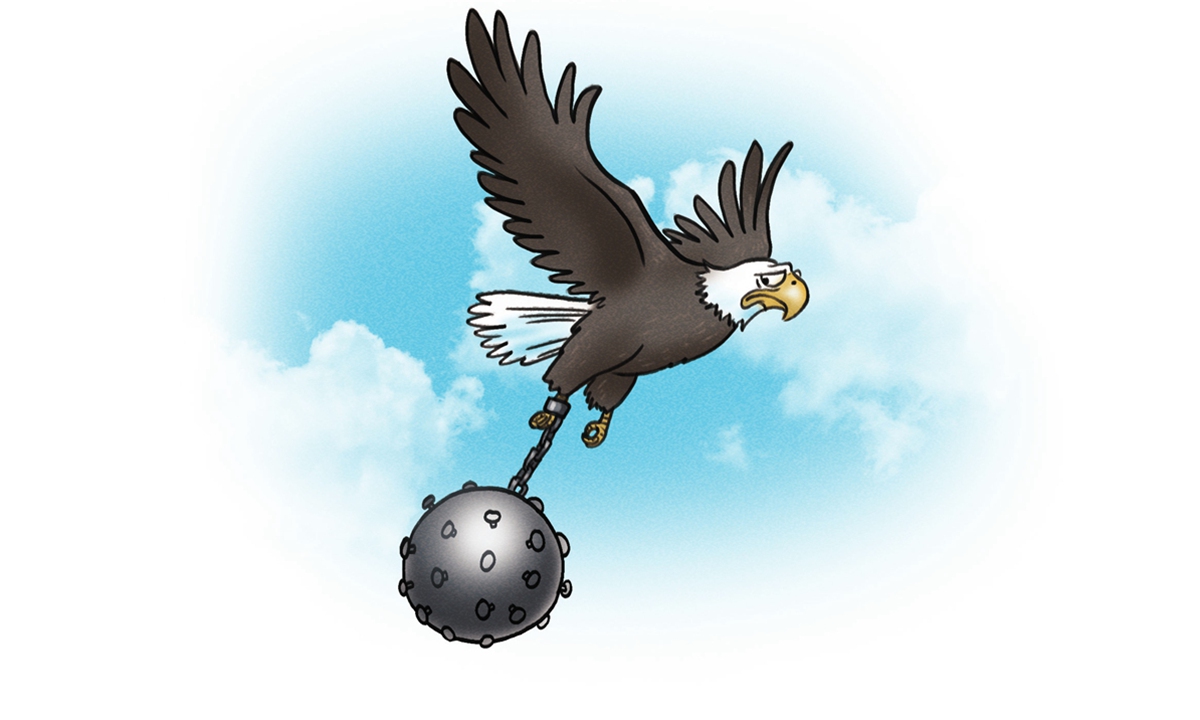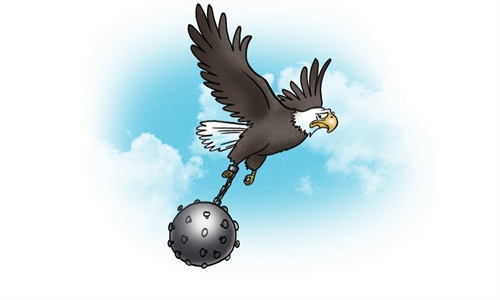Fate of major powers’ strategic expansion: The US’ dominance of Asia-Pacific region is destined to weaken and end

Illustration: Liu Rui/GT
Since the Biden administration took office, one of its focuses has centered on the Asia-Pacific region. The Biden administration continues to make this region a strategic focus, keeping within the tradition that began during the Obama administration. But how long can the US continue to dominate the region? This deserves deep thinking.Since the end of the World War II, the US has strengthened its dominance over the order of the Asia-Pacific region by establishing a gigantic military alliance system. In the field of economics, the US has long been a major trading partner and source of investment for countries in the region. It also has a deep political penetration in the region through its allies and partners. Therefore, in terms of politics, economics and security, the US has an important influence on the Asia-Pacific region. It also plays a role that cannot be ignored in the regional order.
After the end of the Cold War, Washington became obsessed with unipolar hegemonic tendencies. It has kept strengthening its influence in the Asia-Pacific region with an attempt to consolidate its dominance in the region. However, China's rise, to some extent, has impacted the US' dominant role. The US government has therefore viewed China as an important challenge and threat.
During the Obama presidency, the US pursued the "pivot to Asia" policy, also known as the rebalance to Asia-Pacific strategy, the core of which was to consolidate and reinforce US' leadership in the region through the recalibration of strategic focus. The importance Washington attached to the region remained unchanged during Trump's tenure. This happened despite the fact that the Trump administration adopted very different foreign policies from the Obama administration. The Trump administration mainly strengthened the US Asia-Pacific influence through the "Indo-Pacific" strategic framework. It aimed at containing China through multilateral cooperation with its allies and partners. The purpose was to undermine China's influence in the region.
The Biden administration is continuing Trump's Indo-Pacific strategic framework. It organized the first Quad summit not long after taking office and stressed a rules-based order in the region. The containment and crackdown on China has not relaxed under the Biden administration. It is apparent to all that the China-US competition in the Asia-Pacific region is still fierce, arousing global concern.
It can be seen that the Biden administration is busy fighting against the COVID-19 pandemic and resuming economy, yet is also taking great efforts to restore the US' global leadership by returning to multilateralism and repairing relations with allies. The Biden administration is more inclined to use multilateral means to exert pressure on China. Its fundamental purpose is to safeguard the dominant position of the US in the world and the Asia-Pacific region.
To some extent, China-US relations have become the dominant force affecting the Asia-Pacific region. Some people even believe a pattern that Asia-Pacific countries are economically dependent on China yet rely on the US for security has taken shape. But with the intensifying China-US strategic competition, such a pattern is not sustainable. There are also some scholars who believe the region is likely to see the formation of a China-US bipolar pattern with two confrontational camps forming in political, economic and security fields. If this really happens, it will be detrimental to the overall interests of the Asia-Pacific region.
The influence of a country on any regional order depends on four factors: its national strength international mobilization capabilities, regional pattern and regional circumstances. From the perspective of national strength, the US' relative decline has gradually constrained its strategic resource input in the Asia-Pacific region. The possibility of an imbalance between the US' strategic goal and resources will increase. The US' declining strength will also test its international mobilization capabilities, and reduce trust allies and partners have in it.
From the perspective of the Asia-Pacific regional pattern, the balance of power between China and the US is an important factor. But at the same time, countries like Japan, ASEAN nations and India have become important influential players. The regional pattern is no longer dominated by Washington. It has become a multipolar structure. Finally, in terms of regional circumstances, despite some unstable factors, the overall situation in the region is peaceful. Most countries within the region have regarded economic development as their strategic focus.
Although Washington still has a heavy influence on the Asia-Pacific, its dominance of the region is destined to weaken in the future, and it will eventually end. But this is not the result of China-US strategic competition. The end of the US' dominance in the region does not mean that an era of China's dominance in the region is coming. The world today is undergoing major changes unseen in a century. The most important changes will see the weakening of major powers' dominance around the world. This is the inevitable result of the international community's development. And it is the historical fate of major powers' strategic expansion.
The author is secretary-general of the International Security Study Center at China Foreign Affairs University. opinion@globaltimes.com.cn

